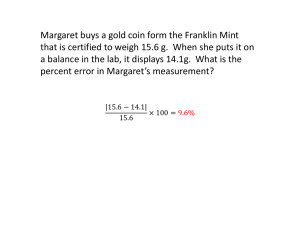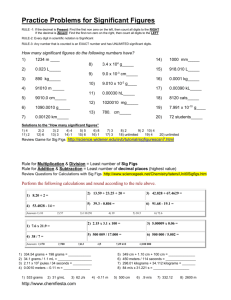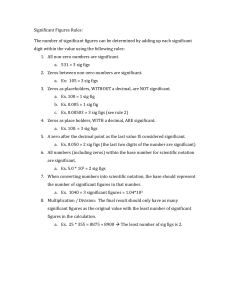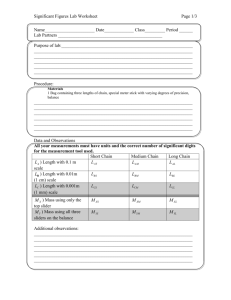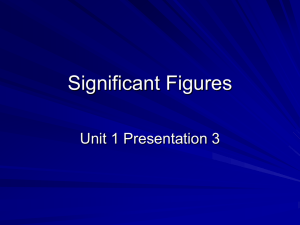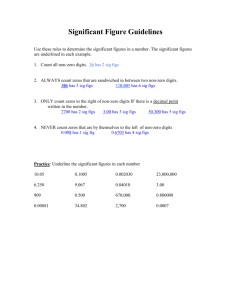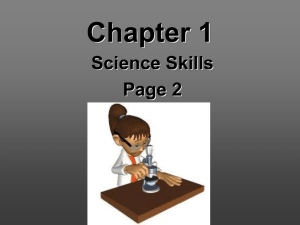CHAPTER 1 CLASSNOTES review notes
advertisement
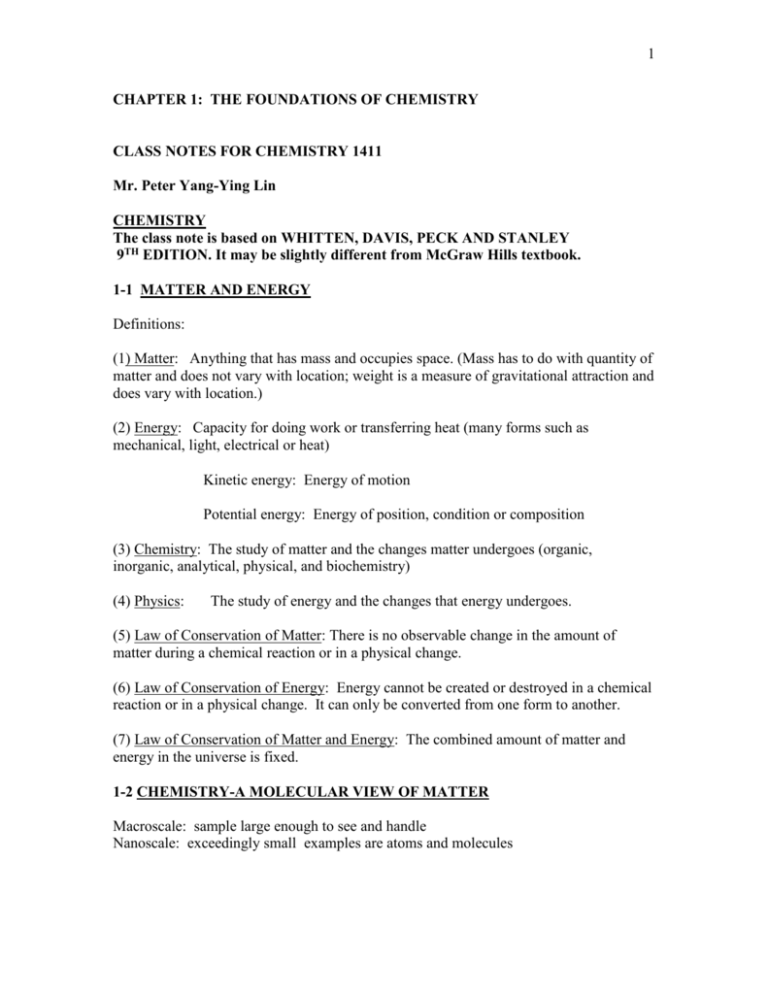
1 CHAPTER 1: THE FOUNDATIONS OF CHEMISTRY CLASS NOTES FOR CHEMISTRY 1411 Mr. Peter Yang-Ying Lin CHEMISTRY The class note is based on WHITTEN, DAVIS, PECK AND STANLEY 9TH EDITION. It may be slightly different from McGraw Hills textbook. 1-1 MATTER AND ENERGY Definitions: (1) Matter: Anything that has mass and occupies space. (Mass has to do with quantity of matter and does not vary with location; weight is a measure of gravitational attraction and does vary with location.) (2) Energy: Capacity for doing work or transferring heat (many forms such as mechanical, light, electrical or heat) Kinetic energy: Energy of motion Potential energy: Energy of position, condition or composition (3) Chemistry: The study of matter and the changes matter undergoes (organic, inorganic, analytical, physical, and biochemistry) (4) Physics: The study of energy and the changes that energy undergoes. (5) Law of Conservation of Matter: There is no observable change in the amount of matter during a chemical reaction or in a physical change. (6) Law of Conservation of Energy: Energy cannot be created or destroyed in a chemical reaction or in a physical change. It can only be converted from one form to another. (7) Law of Conservation of Matter and Energy: The combined amount of matter and energy in the universe is fixed. 1-2 CHEMISTRY-A MOLECULAR VIEW OF MATTER Macroscale: sample large enough to see and handle Nanoscale: exceedingly small examples are atoms and molecules 2 Elements: Basic building blocks of all other matter—can not be broken down to simpler substances by chemical changes—periodic table is a list of the elements—each element has a name and a symbol (abbreviation) which is usually 1 or 2 letters, sometimes from Latin names. Be familiar with the elements in Table 1-3 in the text, page 18. Compounds: Two or more elements combined in a definite ratio and can’t be separated by physical means. Examples: H2O, water; H2O2, hydrogen peroxide Atom: The smallest particle of an element that has the properties of that element through all chemical and physical changes. Subatomic particles(fundamental particles): The major particles that make up the atom— proton, neutron and electron Particle abbreviation proton p neutron n electron e- charge 1+ 0 1- mass 1 amu 1 amu 0 amu Both charge and mass are relative numbers, not absolute. Amu = atomic mass units If the carbon atom is assigned the mass of 12 amu, then the proton is one-twelth as much. Atomic number: The atomic number, Z, of an element is equal to the number of protons in the nucleus of the atom. It is also equal to the number of electrons, if the atom is neutral. Hydrogen has one proton; helium has two protons, lithium has three protons, etc. Atomic mass number (atomic weight): The atomic weight of an element is equal to the sum of the protons and neutrons. Hydrogen has one proton and no neutrons. Helium has two protons and two neutrons. Lithium has three protons and four neutrons. Molecule: A molecule is the smallest particle of an element or a compound that can exist independently. Substance Silver Oxygen Chlorine Water Ammonia Atom Ag O Cl - Molecule Ag (monatomic molecule) O2 (diatomic molecule) Cl2 H2O NH3 3 1-3 STATES OF MATTER Solids: definite shape and definite volume; ~not compressible Liquids: no definite shape, but definite volume; ~not compressible Gases: no definite shape and no definite volume; highly compressible 1-4 CHEMICAL AND PHYSICAL PROPERTIES Physical properties (characteristics): Properties that we can observe and the composition of the substance is not changed. (non-destructive) Examples: color, density, hardness, melting point, boiling point, thermal and electrical conductivities. (Doesn’t depend upon amount for intensive properties.) Chemical properties: Properties that we can observe and the composition of the substance is changed. (destructive) Examples: Will the substance burn? Will the substance tarnish? Will the substance rust? (Doesn’t depend upon amount.) 1-5 CHEMICAL AND PHYSICAL CHANGES Physical changes: Changes that we observe and there is no change in composition of the substance (non-destructive), but energy is released or absorbed. Examples: All phase changes are physical changes. The processes of dissolving or precipitating out are also physical. Chemical changes: Changes that we can observe and there is a change in composition of the substance. New substances are formed and energy is released or absorbed. Examples: Burning, tarnishing, rusting, digesting 1-6 MIXTURES, SUBSTANCES, COMPOUNDS, AND ELEMENTS Matter Pure Substances Elements Compounds Mixtures Heterogeneous Homogeneous Elements: Basis building blocks of all other matter—cannot be broken down to simpler substances by chemical changes—periodic table is a list of the elements—each element has a name and a symbol (abbreviation) which is usually 1 or 2 letters, sometimes from Latin names. Be familiar with the elements in Table 1-3 in the text, page 18. Compounds: Two or more elements combined in a definite ratio and can’t be separated by physical means. Examples: H2O, water; H2O2, hydrogen peroxide 4 Mixtures: Two or more substances mixed together and each substance retains its own properties—no definite ratio and usually easy to separate by physical means such as filtering, decanting, evaporation of a liquid, etc. Heterogeneous mixtures: Mixtures that to the eye do not appear to be the same throughout. Example: sand in water Homogeneous mixtures: Mixtures that to the eye appear the same throughout. Example: salt dissolved in water. 1-7 MEASUREMENTS IN CHEMISTRY In science use the metric system or the SI system. 1-8 UNITS OF MEASUREMENT Prefixes that we use a lot in the metric system: Kilo or K = 1000 or 1 x 103 (text book uses a small k) Centi or c = Milli or m = 1 100 or 0.01 or 1 x 10-2 1 1000 or 0.001 or 1 x 10-3 Mass: Basic unit is the gram (g) in metric system. A nickel is about 5 grams. kilogram (Kg) milligram (mg) 1Kg = 1000 g 1000 mg = 1 g Can make conversion factors out of these: 1 𝐾𝑔 1000 𝑔 1000 𝑔 or 1 𝐾𝑔 1000 𝑚𝑔 1𝑔 or 1𝑔 1000 𝑚𝑔 Length: Basic unit is the meter, (m). A meter is about 1 yard. kilometer (Km) centimeter (cm) millimeter (mm) 1 Km = 1000 m 1 m = 100 cm 1 m = 1000 mm Can make conversion factors out of these: 1 𝐾𝑚 1000 𝑚 1𝑚 100 𝑐𝑚 or or 1000 𝑚 1 𝐾𝑚 100 𝑐𝑚 1𝑚 5 1𝑚 1000 𝑚𝑚 or 1000 𝑚𝑚 1𝑚 Volume: Basic unit is the liter, (L). A liter is about 1 quart. Milliliter (mL) 1 L = 1000 mL Can make a conversion factor: 1 cc = 1 cm3 = 1 mL 1𝐿 1000 𝑚𝐿 One other unit to know: 1 Angstrom = 1 x 10-8 cm Or 1 Angstrom = 1 x 10 -10 m or 1000 𝑚𝐿 1𝐿 or 1 A = 1.0 x 10-8 cm 1-9 USE OF NUMBERS Scientific notation: 4300000 = 4.3 x 106 To put this number in your calculator: Press 4.3; press EE or EXP (Do not press times 10); press 6 It will probably look like 4.3 E 06 on your calculator. 0.000348 = 3.48 x 10-4 To put this number in your calculator: Press 3.48; press EE or EXP; press +/- ; press 4 It will probably look like 3.49 E -04 on your calculator Significant Figures (sig figs) RULES: 1. Nonzero digits are always significant. 38.57 has 4 sig figs. 2. Zeroes are sometimes significant, and sometimes they are not. (a) Zeroes at the beginning of a number are never significant. 0.052 has 2 sig figs. (b) Zeroes between nonzero digits are always significant. 2007 has 4 sig figs. (c) Zeroes at the end of the number that contains a decimal place are significant. 440.0 has 4 sig figs. (d) Zeroes at the end of the number that does not contain a decimal point may or may not be significant. 23000 may have 2, 3, 4 or 5 sig figs depending on how it was measured. (OWL electronic homework will say two sig figs for this number.) 3. Exact numbers can be considered as having an unlimited number of significant figures. Counting number of people in class would give an exact number; there should be no uncertainty in the number. 4. In addition or subtraction, the answer contains no more decimal places than the least number of decimal places used in the operation. 6 Example 1-3 37.24 mL +10.3 mL 47.54 mL but round to 47.5 mL First number has two decimal places and the second number has one decimal place, thus, the answer should have one decimal place. Put units on answer. 5. In multiplication and division, an answer contains no more significant figures than the least number of significant figures used in the operation. Example 1-4 (12.34 cm) × (1.23 cm) = 15.1782 cm 2 but round to 15. 2 cm2 The first number has four sig figs and the second number has three sig figs, thus, the answer should have three sig figs. Put units on answer. Rounding hints: 1. When the number to be dropped is less than 5, the preceding number is left unchanged. 2. When the number to be dropped is greater than 5, the preceding number is increased by 1. 3. When the number to be dropped is exactly 5, the preceding number is set to the nearest even number. 4. Recommendation: If the problem you are working has several steps, wait to round off until the final step. 7 1-10 THE UNIT FACTOR METHOD (DIMENSIONAL ANALYSIS) Example 1-5 English-English conversion 1.47 miles = ________ inches Facts given: 1 mile = 5280 ft 1 ft = 12 inches Therefore the plan is: change miles to feet to inches 1.47 𝑚𝑖𝑙𝑒𝑠 1 × 5280 𝑓𝑡 1 𝑚𝑖𝑙𝑒 × 12 𝑖𝑛𝑐ℎ𝑒𝑠 1 𝑓𝑡 = 93139.2 inches But round to 93100 inches to have 3 sig figs. Or 9.31 x 104 inches. Put units on all your answers and give the correct number of sig figs. Notice that units all cancel, but for the inches in Example 1-5. This is a good safety check on your work; if the units do not cancel, probably one of the conversion factors is inverted. The conversion factors themselves should be treated as absolute numbers and therefore, do not dictate the number of sig figs in the answer. The part that makes the problem unique should dictate sig figs. Example 1-6 1.10 A = _______cm 3 sig figs in 1.10 A Fact: 1 Angstrom or 1 A = 1.0 x 10-8 cm; make a conversion factor from this fact 1.10 𝐴 1 × 1.0 𝑥 10−8 𝑐𝑚 1𝐴 = 1.10 x 10-8 cm 8 Example 1-8 Metric-metric conversion 0.234 mg = __________ g = ____________Kg 0.234 𝑚𝑔 1 0.234 𝑚𝑔 1 × × 1𝑔 1000 𝑚𝑔 1𝑔 1000 𝑚𝑔 3 sig figs in number = 0.000234 g or 2.34 x 10-4 g × 1 𝐾𝑔 1000 𝑔 = 0.000000234 Kg or 2.34 x 10-7 An easier way is to write: KHD unit dcm To help you remember: (Ken’s Horse Died. Unit Diane’s Cat Meowed.) First letter in each word in the two sentences supplies the hints. Where K = kilo H = hecto D = deka Unit d = deci c = centi m = milli 1000 Each is different from the next one by a power of 10. 100 10 1 0.1 0.01 0.001 To use this system for Example 1-8: We start at m (or mg) and want to go to the basic unit. On the line KHD unit dcm, this would be three moves to the left. Take the decimal point and move it three places in the same direction in the number. Thus, 0.234 mg becomes 0.000234g We can always add zeroes. 0.234 mg = ____________Kg On the line KHD unit dcm, this would be six moves to the left; move the decimal point in the number, six places to the left. The answer is 0.000000234 Kg With this system it is possible to move left or right and also across the basic unit. The basic unit in mass would be gram, in volume it would be liter and in length it would be meter. Most people find this is an easier way to do metric-metric conversions, rather than the unit analysis method. The unit analysis should be used for English-English conversions, metric-English or English-metric conversions. 9 For any English-metric or metric-English, you should know the following: Mass 1 lb = 454 g Length 1 in = 2.54 cm Volume 1 qt = 0.946 L Example 1-11 English-metric conversion 1.0 gal = ________ mL There are 2 sig figs. We should expect a large answer. Plan: gallons to quarts to liters to mL’s Fact: 1 gal = 4 qt 1.0 𝑔𝑎𝑙 1 × 4 𝑞𝑡 1 𝑔𝑎𝑙 You will be given any English-English conversion factors needed. × 0.946 𝐿 1 𝑞𝑡 × 1000 𝑚𝐿 1𝐿 = 3.8 x 103 mL Answer to 2 sig figs. Is this reasonable? 1 gallon is 4 quarts and a quart is about 1 liter, thus we have about 4 liters or 4000 mL and we got 3800 mL. Thus, our answer is reasonable. 1-11 PERCENTAGE Example 1-12 U.S. pennies since 1982 are 97.6 % zinc and 2.4 % copper. If the mass of a penny was found to be 1.494 g, how many grams of zinc does it contain? 97.6 𝑔 𝑧𝑖𝑛𝑐 Per cent means parts per hundred. Thus, 97.6 % is 100 𝑔 𝑜𝑓 𝑠𝑎𝑚𝑝𝑙𝑒 1.494 𝑔 𝑠𝑎𝑚𝑝𝑙𝑒 1 × 97.6 𝑔 𝑍𝑛 100 𝑔 𝑠𝑎𝑚𝑝𝑙𝑒 = 1.46 g of zinc Answer has 3 sig figs. and the units are g of zinc. 1-12 DENSITY AND SPECIFIC GRAVITY Density = mass/volume Units are usually g/mL or g/cm3 density. or D = 𝑚 𝑣 Since 1 mL = 1 cm3 , these give identical numbers for 10 Example 1-13 47.3 mL of ethyl alcohol (ethanol) has a mass of 37.32 g. What is its density? D= 𝑚 D= This equation has three variables; two must be given in any density problem. 𝑣 37.32 𝑔 47.3 𝑚𝐿 The answer should have 3 sig figs. D = 0.789 g/mL Example 1-14 116 g of ethanol is needed for a chemical reaction, what volume of liquid would you measure out, if you knew that the density was 0.789 g/mL? D= 𝑚 This time we know D and m, but not V. 𝑣 Multiply both sides by V and we get: Dv = m Divide both sides by D, so that v stands alone. v = 𝑚 𝐷 116 𝑔 0.789 𝑔/𝑚𝐿 = 147 mL We want 3 sig figs. in answer. 1 Notice that g and g cancel and that leaves 1/𝑚𝐿 a complex fraction for the units. mL comes around on top to give us mL as the final unit. 11 Example 1-16 Specific gravity is defined: specific gravity = 𝐷 𝑜𝑓 𝑆𝑢𝑏𝑠𝑡𝑎𝑛𝑐𝑒 𝐷 𝑜𝑓 𝑤𝑎𝑡𝑒𝑟 It’s a comparison to the density of water. (The density of water is 1.00 g/mL at 20 oC) 𝑚 D= 𝑣 If the density of sodium chloride is 2.16 g/mL, what is its specific gravity? S. G. = 2.16 𝑔/𝑚𝐿 1.00 𝑔/𝑚𝐿 = 2.16 with no units. Example 1-17 Battery acid is 40.0% sulfuric acid and 60.0% water by mass. Its specific gravity is 1.31. Calculate the mass of pure sulfuric acid in 100.0 mL of the acid solution. First change S. G. to density. D = 1.31 g/mL (Just add the units back). 100.0 mL of solution would be how many g of solution? D= 𝑚 𝑣 D = Multiply both sides by v. Dv = m (1.31 g/mL)(100.0 mL) = 131 g of solution It is 40.0 % sulfuric acid, so we take 40.0% of the 131 g of solution. 131 𝑔 𝑜𝑓 𝑠𝑜𝑙𝑢𝑡𝑖𝑜𝑛 1 × 40.0 𝑔 𝑜𝑓 𝑠𝑢𝑙𝑓𝑢𝑟𝑖𝑐 𝑎𝑐𝑖𝑑 100 𝑔 𝑜𝑓 𝑠𝑜𝑙𝑢𝑡𝑖𝑜𝑛 Notice three sig figs. in answer. = 52.4 g of sulfuric acid 12 . 1-13 HEAT AND TEMPERATURE Heat is a form of energy. Temperature is a measure of the intensity of the heat—the hotness or coldness of the object. In this country, we use Fahrenheit, oF. Water freezes at 32 oF and boils at 212 oF at 1 atm pressure. In chemistry, we usually use the Celsius scale, oC. On this scale at 1 atm pressure, water freezes at 0.0 oC and boils at 100.0 oC. The equation to convert is: solve for the other. o F = 1.8 oC + 32 Either oF or oC will be given and then Example 1-18 o 100 F= ________oC o F = 1.8 oC + 32 Rearrange by subtracting 32 from each side and then divide both sides by 1.8, so that C stands alone. 𝐹−32 o = C 1.8 100−32 1.8 = 38oC Another temperature scale is the Kelvin, K, or absolute scale. If –273oC is the lowest temperature possible, then to avoid negative numbers, on the Kelvin scale, this was set at 0. The size of the degree is the same on Kelvin and Celsius, thus, K = oC + 273 13 Example 1-19 400 K = ________oF Need two equations: K = oC + 273 or rearrange K – 273 = oC o 400 – 273 = 127 C o F = 1.8oC + 32 o F = 1.8(127) + 32 = 261 oF 1-14 HEAT TRANSFER AND THE MEASUREMENT OF HEAT Specific heat of a substance: Amount of heat required to raise the temperature of one gram of the substance by one degree C. Heat can be measured in calories or in Joules. Calorie: Amount of heat needed to raise the temperature of one gram of water from 14.5oC to 15.5oC. One calorie = 4.18 Joules (J) to 3 sig figs. The specific heat of water in the liquid state is: 4.18 J/g . oC Example 1-20 How much heat is required to raise the temperature of 205 g of water from 21.2oC to 91.4oC? Heat = (mass of substance)(specific heat of substance)(change in temperature) Heat = (205 g)×(4.18 J/g . oC)×(70.2oC) = 60200 J to 3 sig figs. Or 6.02 x 104 J Or the answer could be expressed as 60.2 KJ. All units cancel, but J in the equation. 14 Example 1-21 A 588 g piece of iron is heated to 97.5 oC. It is then dropped into 247 g of water originally at 20.7 oC. When the system has equilibrated, the water and iron are both at 36.2 oC. Calculate the specific heat of iron. Specific heat of water is 4.18 J/g . oC We must assume that heat lost by the iron is exactly equal to the heat gained by the water. Heat lost = heat gained Heat lost =(mass iron)×(spec. heat of iron)×(change of temp. for the iron) =(588)×(x)×(61.3) Heat gained = (mass of water)(spec. heat of water)(change of temp. for the water) =(247)×(4.18)×(15.5) Set these two equal to each other and solve for x. x = 0.444 J/g . oC Example 1-22 We add the same amount of heat to 10.0 g of each of the following substances starting at 20.0 o C liquid water, liquid mercury, liquid benzene and solid aluminum. Rank the samples from lowest to highest final temperature. Use the following values for specific heats: H2O(l) Specific heat = 4.18 J/g C Hg(l) Specific heat = 0.138 J/g C C6H6(l) Specific heat = 1.74 J/g C Al(s) Specific heat = 0.900 J/g C. Water < benzene < aluminum < mercury END OF CHAPTER 1 NOTES 15


